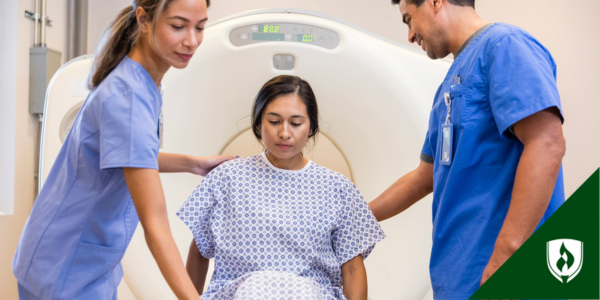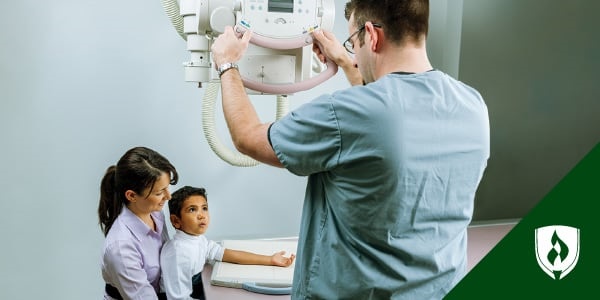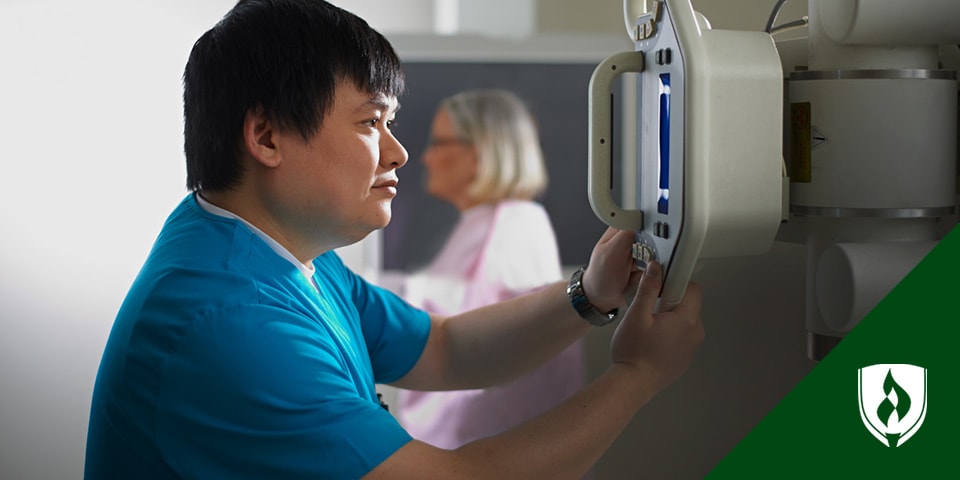What Does an X-Ray Tech Do? A Clearer Picture of This Radiology Role
By Ashley Brooks on 02/18/2019

Lately you’ve been reliving the vivid memory of the day you broke your arm as a kid. Despite the pain, you have to admit it was pretty cool to see what the inside of your arm looked like, thanks to X-ray imaging. Back then, you didn’t give much thought to the skilled professional taking those X-rays. Now that you’re searching for a new career, however, the role of an X-ray tech is at the top of your mind.
You might have a basic grasp of the job—they help produce X-ray images. But there’s a lot more to learn about what an X-ray tech does before deciding whether this is the right healthcare career for you.
To help with this, we’ve dug into the day-to-day work and picked the brain of an experienced X-ray tech. Take a look at these answers to all your big questions about this exciting radiology career.
What does an X-ray tech do?
X-ray techs are a type of radiologic technologist, who is a healthcare professional specializing in using equipment to take diagnostic imagery of patients. “In a nutshell, X-ray techs care for patients while they perform a large variety of radiographic procedures,” says Crystal Bromeling, Radiologic Technology program coordinator at Rasmussen University.
You’re probably familiar with X-ray techs as taking, well, X-rays—but radiologic technologists can also be responsible for other types of diagnostic imagery, such as CT scans and MRIs. “Everyone knows that we take X-rays, but what they may not know is that we cross-train in many different modalities such as MRI or ultrasound,” Bromeling says.
X-ray techs can be found preparing patients for imaging procedures, maintaining and operating equipment, and working with physicians to read the results of an imaging scan. It might sound straightforward, but these healthcare professionals play a vital role in patient care. “We educate patients who are fearful of medical procedures. We work very closely with all medical providers and may help determine a good course of treatment,” Bromeling says.
Where does an X-ray tech work?
More than half of all radiologic techs work in hospitals, according to the Bureau of Labor Statistics (BLS). However, X-ray techs are needed in many types of medical facilities, including hospitals, clinics, diagnostic labs and urgent care centers. Depending on the facility, some X-ray techs may need to work holidays, weekends or overnight to care for patients in emergency situations.
An X-ray tech’s work environment also has some impact on their daily job duties. “We can work at clinics where we triage patients by taking their vitals, asking medical history questions and performing simple lab procedures. In a large facility, we may assist during surgical procedures with the use of fluoroscopy,” Bromeling says.
There are plenty of options for X-ray techs to work in a healthcare facility that matches their scheduling needs, interests and specialties.
What skills do X-ray techs need?
Operating specialized equipment can sound intimidating, but aspiring X-ray techs can rest assured that a high-quality training program will prepare them to do the job. You might also be surprised to learn that soft skills play a large role in this career—and you might already have some of the qualities you need on the job!
Bromeling shares that a successful X-ray tech should be able to work well with others, both as part of a medical team and as someone who directly interacts with patients. Communication and critical-thinking skills also come in handy, as well as the ability to work in a fast-paced environment.
Take a look at these in-demand skills employers are looking for in their X-ray techs. You might discover that the skills you need to embark on this career aren’t as intimidating as you once thought.
Top technical skills for X-ray techs1
- X-ray imaging
- Radiology
- Patient care
- Patient preparation
- Vital signs measurement
- Urgent care
- CPR
- Injections
- Patient flow
- Radiation protection
Top transferable skills for X-ray techs1
- Communication
- Relationship-building
- Computer literacy
- Collaboration
- Telephone skills
- Listening
Picture your future career
Job prospects appear solid for X-ray techs and radiologic technologists. The BLS projects a 12 percent growth in employment for X-ray techs from 2016 to 2026. That’s a rate higher than the national average and could result in an additional 30,300 jobs!2
Now that you know more about what an X-ray tech does, you might be picturing yourself in this radiology career. If that’s the case, you’re probably wondering what you’ll need to do to become one. Uncover the answer with our article, “How to Become an X-ray Tech: Your Step-by-Step Guide.”
1Source: Burning-Glass.com (analysis of 3,209 X-ray technician job postings, Nov. 01, 2017- Oct. 31, 2018).
2Bureau of Labor Statistics, U.S. Department of Labor, Occupational Outlook Handbook, [career information accessed January 14, 2019] www.bls.gov/ooh/. Data represents national, averaged earnings for the occupations listed and includes workers at all levels of education and experience. Employment conditions in your area may vary.


.jpg)

